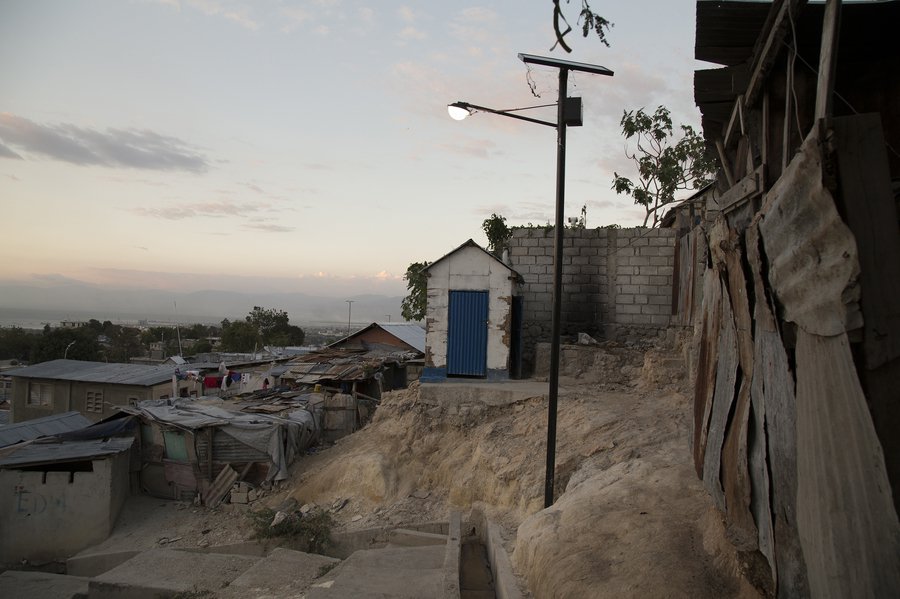When a devastating earthquake leveled Haiti in 2010, millions of people donated to the American Red Cross. The charity raised almost half a billion dollars. It was one of its most successful fundraising efforts ever.
The American Red Cross vowed to help Haitians rebuild, but after five years the Red Cross’ legacy in Haiti is not new roads, or schools, or hundreds of new homes. It’s difficult to know where all the money went.
The Red Cross says it has provided homes to more than 130,000 people, but the number of permanent homes the charity has built is six.
The Red Cross long has been known for providing emergency disaster relief — food, blankets and shelter to people in need. And after the earthquake, it did that work in Haiti, too. But the Red Cross has very little experience in the difficult work of rebuilding in a developing country.
The organization, which in 2010 had a $100 million deficit, out-raised other charities by hundreds of millions of dollars — and kept raising money well after it had enough for its emergency relief. But where exactly did that money go?
Ask a lot of Haitians — even the country’s former prime minister — and they will tell you they don’t have any idea.
“Five hundred million in Haiti is a lot of money,” says Jean-Max Bellerive, who was prime minister until 2011. “I’m not a big mathematician, but I can make some additions. It doesn’t add up for me.”
On a recent day, Bellerive was sipping coffee in his living room, high above Port-au-Prince, with Joel Boutroue, who was the United Nations deputy special representative in Haiti before the earthquake and an advisor to the Haitian government afterward. Boutroue says he can’t account for where the nearly $500 million went either.
They considered the Red Cross’ claim on its website and press releases: That all the money went to help 4.5 million Haitians get “back on their feet.”
“No, no, not possible,” Bellerive says. “We don’t have that population in the area affected by the earthquake.”
“You know,” Boutroue chimes in, “4.5 million was 100 percent of the urban area in 2010. One hundred percent. It would mean the American Red Cross would have served entire cities of Haiti.”
It’s not unheard of for the Red Cross to make such a claim. Not long ago, the charity hired a group of consultants to review one of its projects in the north of the country. They found the charity’s math unreliable when it came to counting people it helped. There was double-counting, undercounting, and in one instance the Red Cross claimed to have helped more people than actually lived there.
David Meltzer, the Red Cross’ general counsel and head of the international division, says the charity helped millions through trying and difficult circumstances, including a cholera outbreak and a government in disarray.
“The Red Cross has provided clean water, sanitation, vaccinations, disaster preparedness, cholera prevention,” he says. “All of the money that has been spent has been focused on benefiting the people of Haiti.”
Meltzer says the Red Cross took the almost $500 million and split it into sectors. For example, the organization spent $69 million on emergency relief, $170 million providing shelter and $49 million on water and sanitation efforts.
The Red Cross also has outlined over the years some of the projects it has funded, such as millions of dollars given for new hospitals, vaccination programs, and disbursement of tents and water tablets. The charity says it has done more than 100 projects in Haiti, repairing 4,000 homes, giving several thousand families temporary shelters and donating $44 million for food.
But the charity will not provide a list of specific programs it ran, how much they cost or what their expenses were.
Meltzer says the public can see in the organization’s five-year report: a pie chart showing the percentage of the money that went to each sector. But he will not provide greater detail about where the money went.
“We have provided, through our public website, where the money has gone by sector, and we stand by the accuracy of that information,” he says.
The charity’s own documents, however, give some insight: Much of the money never reached people in need.
The Red Cross gave much of the money to other groups to do the hands-on work, resulting in additional fees.
First the Red Cross took a customary administrative cut, then the charities that received the money took their own fees. And then, according to the Red Cross’ records, the charity took out an additional amount to pay for what it calls the “program costs incurred in managing” these third-party projects.
In one of the programs reviewed by NPR and ProPublica, these costs ate up a third of the money that was supposed to help Haitians.
To really understand what happened, take a look at one of the Red Cross’ marquee projects — a housing project. The housing sector received more than double the funds that other sectors received, and it’s the area in which the Red Cross made its biggest promises.
Campeche and the surrounding neighborhoods are home to one of those projects. The town sits in a ravine in the hills of Port-au-Prince. People live inside shacks made of tarps and tin. There’s no running water. Trash and human waste piles up at the bottom of the hill.
The residents here will get a new road, and some homes and schools will be repaired. But like much of the American Red Cross’ work in this country in the five years after the earthquake, that was not what residents expected




